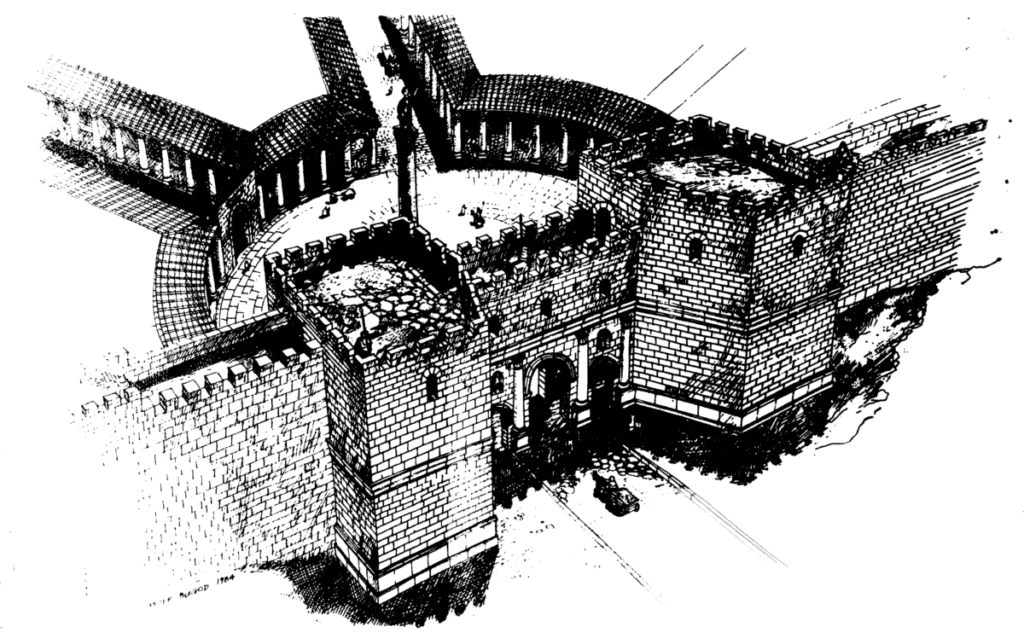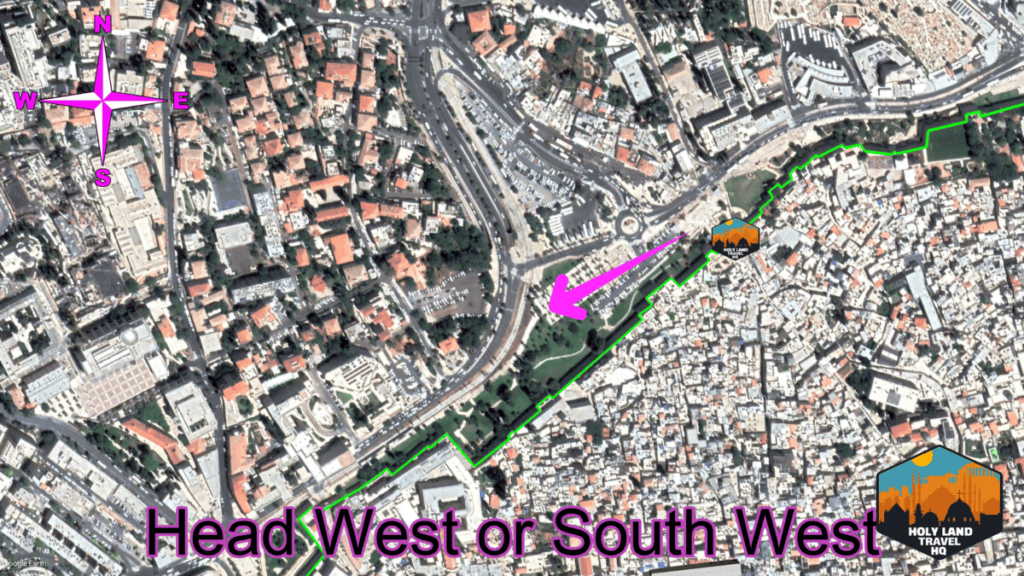- Gates Main
- Jaffa Gate
- Zion Gate
- Dung Gate
- East Gate (also known as Golden Gate)
- Lion’s Gate
- Herod’s Gate
- Damascus Gate
- New Gate
What is the Muslim name for Damascus Gate?

Known as Bab al-Amud (باب العامود) in Arabic, or the ‘Gate of the Column,’ Damascus Gate is the primary northern entrance to Jerusalem’s Old City. The current gatehouse and facade were constructed by the Ottoman ruler Suleiman the Magnificent in 1537 and 1538. However, the gate has gone through several iterations as far back as the Roman Period and possibly the Second temple Period.
The gate’s Roman history.
During the Second Temple Period, under Herod the Great’s reign, the limits of the city of Jerusalem expanded. Some scholars believe that it is very possible that the third wall may have gone as far north as today’s northern wall. They argue that there could have been a pre-Roman gate at the site of Damascus gate. This is more of a hypothesis though.
In the 2nd century AD, after the Bar Kokhba Revolt, the Romans had had enough of the Jewish people. Emperor Hadrian changed the name of the province to Palestine to spite the Jews by using the name of their former enemy, the Philistines. He also changed the name of Jerusalem to Aelia Capitolina. To commemorate the Roman victory over the Jewish revolt a victory gate was erected on the spot that is Damascus gate today.

Wikimedia Commons. Public Domain.
The gate is said to have been a stand-alone structure as protective walls were not built until the end of the 3rd century AD. Inside the gate was a public square with a column in the middle in which a statue of Hadrian was mounted on top. Because of this, the gate received the name, the ‘Gate of the Column.’ Or, Bab al-Amud.
The Roman victory gate is thought to have had three arches, with the center arch being bigger than the two side arches. Today, one of the side arches can be seen below the entrance to Damascus Gate. It was discovered and archaeological excavations were carried out in the 1960s and then again in the 1980s.
The Roman name for Damascus Gate.
During the Roman period the gate was also called ‘Neapolis Gate’ after the Roman city of Flavia Neapolis. This is because the gate led out of the city to the road that headed north to Neapolis. Today that city is called Nablus. As a result, Muslims and Jews also call the gate Nablus Gate.
The Roman gate remained in use throughout most of the Muslim and Crusader periods. It is unknown how the gate transformed to its Ottoman form. Whether it had been destroyed and the Ottoman’s built a new gate on the site; or if the Ottomans simply transformed and redesigned it. What is known is that the layout of the gate’s façade is modeled after the Roman gate. This is because the modern gate sits on top of the foundation of the Roman gate.
What is the Hebrew name for Damascus Gate?
Jews call the gate, Sha’ar Shechem (שַׁעַר שְׁכֶם), or ‘Shechem Gate.’ Shechem was an ancient Israelite city that became the primary Samaritan settlement in the Greek and Roman periods. It was destroyed by the Romans during the first Jewish revolt against the Romans in 67 AD. The Romans then built the city of Flavious Neapolis on top of it.
What is the Christian Name for Damascus Gate?
During the Crusades, Christians called the gate Saint Stephen’s Gate because of the location of Saint Stephen’s church just north of the gate. There are some legends that say Stephen was stoned to death outside of the gate. This claim cannot be validated though, as the gate did not exist at the time of Stephen’s death. The other issue is that the claim has also been attributed to Lion’s Gate.
Sometimes Damascus Gate is also referred to as the Fish Gate. The book of Nehemiah refers to a gate on the north side of the city by this name because a fish market operated inside the northern part of the city. Due to the fact that Nehemiah’s wall did not go as far north as the modern wall, this name is only an association.
Christians call the gate Damascus Gate because it leads north towards Damascus. Many believe it to be the most visually pleasing gate of all the gates of the Old City as well. It’s crown-like upper-level cat walk and angled towers make it distinctive and unique among the gates.
The design of Damascus Gate.

The layout of the gatehouse is similar to other Ottoman gates with one exception. Instead of a single 90-degree turn, Damascus gate utilizes two 90-degree turns. Again, a 90-degree turn forces attackers to slow down as they get caught up in a bottleneck of sorts. The gate has two mashikuli balconies which allow defenders to drop hot oil, or excrement on attackers. And it has several slits for defenders to hurl projectiles out of.
What to do if there is conflict at Damascus Gate.
Today, Damascus Gate leads into the Muslim Quarter. Outside of the gate sits a Muslim neighborhood. Of all the gates of Jerusalem’s Old City, Damascus Gate tends to draw the most trouble. As a result, an Israeli Police guard house sits outside the gate overseeing the public square.
Conflict at the gate is not frequent, but it does happen. If you hear news of potential demonstrations outside Damascus Gate, its best to stay away. Visit the gate later in the day or another time.

If you do see violence erupt, depart the area immediately. Your best option is to head west, towards New Gate as the sidewalk is wide and best suited for large fast-moving crowds. Also know that most, if not all, incidents at Damascus Gate happen between male Palestinian youths and the police. They typically do not involve foreign tourists, but that is not always the case.
References:
https://historicalsitesinisrael.com/en/damascus-gate-jerusalem
https://madainproject.com/damascus_gate
https://www.antiquities.org.il/jerusalemWalls/preservation_e02shchem_hstry.asp
Matev, Ami. “One Square Kilometer: The Old City – A Guide to the Sites. 2015. Old City Press.

